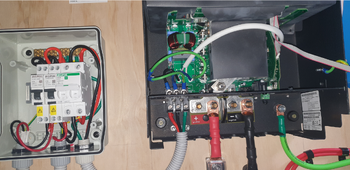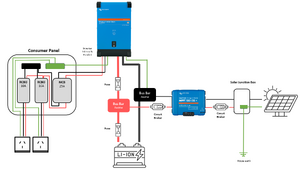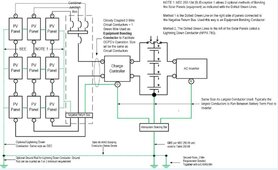Hi,
I'm building a 100% off-grid system (i.e. no AC inputs, AC outputs not connected to house wiring or Grid) and have some questions around Neutral-to-Ground (NG) bonding, grounding equipment and earthing.
I've read the grounding PDF manuals from this site and many posts. The purpose of this post is to get additional forum input, thoughts and advice as an overall sanity check. I intend to call out an electrician once I've set up my system. I've included diagrams and images for reference.
These are my basic components:
Things you should know and some of my assumptions:
So here are my questions please:
If you've read this far I thank you.
Looking forward to your responses.
Regards
*** Image - High-Level Schema

*** Image - Overall system setup (pre-solar connection)

*** Image - Inside view

*** Image - Victron Manual > Internal Bond (page 21)

*** Image - Victron Manual > Grounding the Inverter (page 5)

I'm building a 100% off-grid system (i.e. no AC inputs, AC outputs not connected to house wiring or Grid) and have some questions around Neutral-to-Ground (NG) bonding, grounding equipment and earthing.
I've read the grounding PDF manuals from this site and many posts. The purpose of this post is to get additional forum input, thoughts and advice as an overall sanity check. I intend to call out an electrician once I've set up my system. I've included diagrams and images for reference.
These are my basic components:
- 24V 3000VA Victron Phoenix Smart Inverter
- 2 x 12V 200Ah Renogy batteries in series
- 2 x Victron MPPT charge controllers
- ~830W solar panels
- AC Consumer Panel with 1 x MCB (25A) and 2 x RCBO (16A and 10A) (which feed wall outlets)
Things you should know and some of my assumptions:
- The solar panel frames are grounded to earth.
- Victron's manual (see image below) says the inverter is internally NG bonded. I tested the inverter AC voltage from Hot to Neutral, Hot to Ground and Neutral to Ground and the test results came up 240V, 240V and 0V, respectively, which I'm told is one way to confirm an internal bond. I haven't done any other tests.
- I've grounded my Inverter chassis as recommended by Victron's manual (see image below), which says you should ground the inverter chassis using "at least half the cross-section of the conductors used for the battery connection". I grounded using a 4 AWG wire running from the Inverter earth lug to DC neutral. I did it like this because from what I've read, you should ground DC components to DC neutral so that excess current generated by a ground fault can trip a fuse/breaker.
- I'll admit, there is one electrical concept I don't quite fully understand and that is how do you treat the AC side and DC side of an off-grid setup like mine - that is, as one entire system or as separate systems with their own electrical rules to follow. I think my lack of understanding here may be the reason why I'm asking some of the questions below and the way I'm asking them. So apologies in advance for my ignorance.
So here are my questions please:
- Should I leave the inverter internally bonded OR should I unbond the inverter and move the NG bond to my consumer panel? Are there pros/cons to where the NG bond should exist? I've read differing opinions on this forum.
- Does the rule "There can only be one (1) neutral to ground bond across the entire electrical system" refer to both the AC and DC side of the system? That is, if you create a NG bond on the AC side, does that mean you shouldn't NG bond anywhere else, including anywhere on the DC side?
- As stated above, on the DC side I have grounded my Inverter case to DC Neutral. Does this mean I've unintentionally created a 2nd NG bond? If yes, then how do I reconcile this with general consensus that you should ground DC-side components to DC neutral?
- Where in my system should I earth? I'm thinking on the AC side (e.g. from the Consumer Panel ground busbar) and the DC side (e.g. from DC neutral busbar). Is that ok?
If you've read this far I thank you.
Looking forward to your responses.
Regards
*** Image - High-Level Schema

*** Image - Overall system setup (pre-solar connection)

*** Image - Inside view

*** Image - Victron Manual > Internal Bond (page 21)

*** Image - Victron Manual > Grounding the Inverter (page 5)








